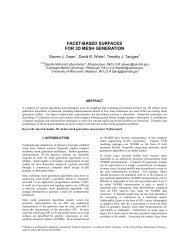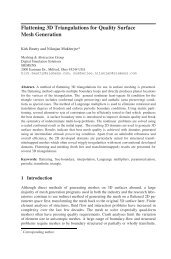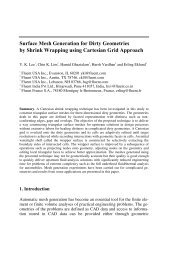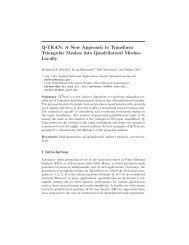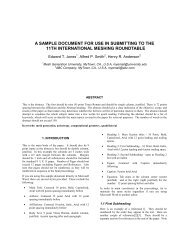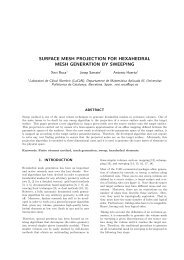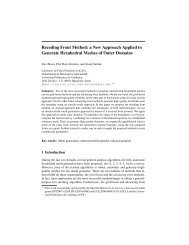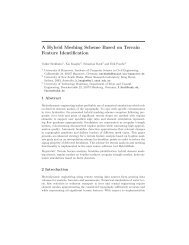Fitting Polynomial Surfaces to Triangular Meshes with Voronoi ...
Fitting Polynomial Surfaces to Triangular Meshes with Voronoi ...
Fitting Polynomial Surfaces to Triangular Meshes with Voronoi ...
Create successful ePaper yourself
Turn your PDF publications into a flip-book with our unique Google optimized e-Paper software.
3.5 <strong>Fitting</strong> <strong>Polynomial</strong> <strong>Surfaces</strong><br />
<strong>Voronoi</strong> Squared Distance Minimization 11<br />
We consider now the problem of fitting a polynomial surface defined by its<br />
control mesh C. At each iteration, we compute a polygonal approximation S<br />
of the polynomial surface. The vertices X of S are given as linear combinations<br />
of the control points P :<br />
X = MP<br />
where X = [x 1 y 1 z 1 . . . x n y n z n ] t denotes the coordinates at the vertices of S, P<br />
denotes the coordinates at the control points. One may use the exact evaluation<br />
of the polynomial surface, or simply use the approximation obtained by<br />
subdividing the control mesh several times <strong>with</strong> De Casteljau’s rule.<br />
<strong>Polynomial</strong> surface fitting is done by minimizing the function G(P) =<br />
˜F(MP). This can implemented <strong>with</strong> a change of variable in the VSDM algorithm<br />
(see Algorithm 2) :<br />
P (0) ← vertices of C (0)<br />
Y ← ε-sampling of T ; Compute Vor(Y)<br />
while minimum not reached do<br />
X ← MP (k) ; Update S from X<br />
Compute ˜F(X) and ∇ ˜F(X) as in Algo. 1, steps (3) <strong>to</strong> (7)<br />
Compute ∇G(P) = M t ∇ ˜F(X)<br />
P (k+1) ← P (k) + p (k)<br />
end<br />
Algorithm 2: <strong>Fitting</strong> a polynomial surface.<br />
3.6 Feature-Sensitive <strong>Fitting</strong><br />
Using the algorithm above for fitting polynomial surfaces may result in oversmoothing<br />
sharp creases (Figure 7 center). However, this can be improved by<br />
injecting normal anisotropy [11] in<strong>to</strong> the objective function ˜F (Figure 7 right).<br />
This changes the terms ˜F T →S and ˜F S→T as follows :<br />
˜F s T →S<br />
= ∑<br />
x i ∈X<br />
˜F<br />
S→T s = ∑<br />
y j ∈Y<br />
where :<br />
∫<br />
∑<br />
T⊂T ∩Ω i T<br />
∑<br />
T⊂S∩Ω j<br />
∫<br />
T<br />
‖ A s (N T )(y − x i ) ‖ 2 dy<br />
‖ A s (N j )(x − y j ) ‖ 2 dx<br />
(6)<br />
⎛<br />
N x [N] t ⎞<br />
A s (N) = (s − 1) ⎝N y [N] t ⎠ + I 3×3<br />
N z [N] t<br />
where the parameter s ∈ (0, +∞) specifies the importance of normal anisotropy.<br />
The normals are sampled from the input surface T in both terms, N T is the<br />
normal of the triangle T, and N j the normal <strong>to</strong> T at y j . Normal anisotropy is<br />
used in all the examples shown below.




